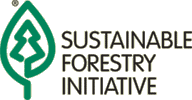LEED’s Artificial Barriers Continue to Fail Responsible Forestry
(3BL Media) Washington, DC - March 6, 2012 - The U.S. Green Building Council (USGBC) continues to put up artificial barriers in its latest draft of its LEED rating tool, shutting out 75 percent of North America's certified forests from the LEED credits that deal with "responsible extraction of raw materials." The third draft of LEED 2012, released on March 1, includes credits for certified wood that is "FSC or better."
"This new language raises more issues than it resolves: Who will decide what is 'better than FSC' and on what basis?" saidKathy Abusow, President and CEO of Sustainable Forestry Initiative® Inc. (SFI®). "SFI clearly has requirements that are not matched by FSC varying standards around the world. This fact continues to go unrecognized by the USGBC, despite the fact that governors, congressmen, and 6,000 individuals have urged the USGBC not to turn its back on North American forests and recognize all forest certification standards."
Currently LEED only recognizes forests certified to the Forest Stewardship Council (FSC), which account for about one quarter of North America's certified forests. The rest are certified to three independent standards in use across North America – SFI, Canadian Standards Association (CSA) and American Tree Farm System (ATFS), all of which are endorsed by the international Programme for the Endorsement of Forest Certification (PEFC).
"SFI is a strong advocate for green building and for all credible forest certification," said Abusow. "With 90 percent of the world's forests not certified to any standard, it's time to break down LEED's artificial barriers and raise understanding of forest certification and the important role it can play in green building."
Abusow said there is independent evidence that SFI standards are as effective as FSC standards, and exceed them in many areas – such as research, support for family forest owners, use of best management practices and the training of more than 130,000 loggers since 1995. SFI also accepts fiber from forests certified to CSA and ATFS, which is important to workers and resource communities throughout North America.
Ignoring these important distinguishing attributes of the SFI program means that a FSC policy in LEED may result in building professionals seeking LEED certification points to purchase wood and paper products from overseas since the majority of FSC's lands are outside of North America. This is both a concern to SFI and a probability according to FSC's own statistics, as evidenced by FSC's own 2010 Business Value and Growth market survey which found: "Nearly half of respondents have sought out an alternative supplier in another country when FSC certified timber or products were not available in their own country."
Builders who want to support North American forests, communities and jobs can choose a green building program which recognizes all forest certification standards. Leading green building rating programs that recognize all credible forest certification programs include the new International Green Construction Code, ANSI/ICC 700-2008: National Green Building Standard, ANSI-GBI 01-2010 Green Building Assessment Protocol for Commercial Buildings, Built Green Canada, BREEAM (United Kingdom) and CASBEE (Japan).
Approximately 100 government officials, including 14 governors, have written to the USGBC calling for fair treatment of wood and forest certification standards. With little visible progress from USGBC, Maine Governor Paul LePage signed an executive order, in December 2011, directing that new or expanded state buildings incorporate green building tools that give equal credit to products certified to SFI, FSC, ATFS and PEFC-endorsed standards. This order would exclude LEED as long as it continues to recognize only FSC – which is currently the case in its existing standards and in its proposed draft standards.
Abusow urged supporters of forest certification to vote no and send USGBC a message that it is time to accept all forest certification programs if LEED cares about responsible forestry. The LEED Rating System Third Public Comment Period is open until March 20, 2012, and comments can be submitted through www.usgbc.org/DisplayPage.aspx?CMSPageID=2360. At the end of the review period, USGBC members will vote on the final draft.
About SFI Inc.
SFI Inc. (www.sfiprogram.org) is an independent 501(c)(3) non-profit charitable organization, and is solely responsible for maintaining, overseeing and improving the internationally recognized Sustainable Forestry Initiative (SFI) program. Across North America, more than 195 million acres/79 million hectares are certified to the SFI forest management standard, making it the largest single forest standard in the world.

